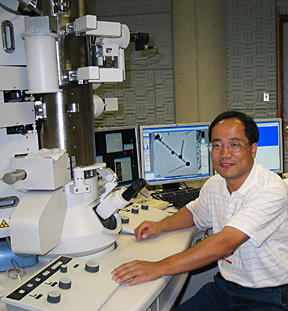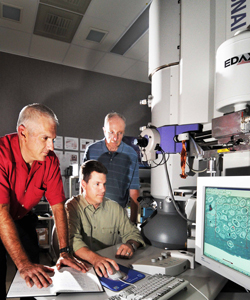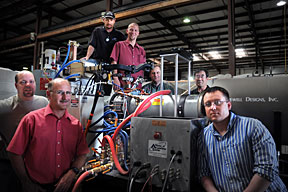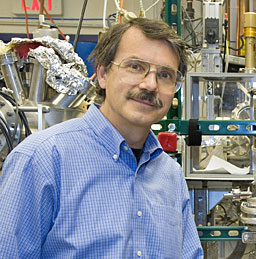| Research
|
Alex Zettl makes the most incredible devices you’ll never see—at least not without the aid of an electron microscope. Zettl, a physicist who holds a joint appointment with Lawrence Berkeley National Laboratory (Berkeley Lab) and the University of California (UC) at Berkeley, is as close to being a modern day wizard as you will ever meet. In his laboratory, he and his research group have conjured such wonders as a motor 300 times smaller than the diameter of a human hair, a scale that can weigh individual atoms, and the world’s first real nanopod—a fully functional radio made from a single carbon nanotube. Even the most conservative seers have predicted that nanotechnology will revolutionize the production and use of materials and for over a decade Zettl has been at the forefront of nanoscale science. Working with these super hard, super strong, super useful hollow tubular macromolecules, he began by fashioning the world’s smallest human-made bearings and mechanical switches, the world's smallest room-temperature diodes, and a "tube cube" electronic device with the potential to wire itself. “To me one of the most exciting aspects of nanoscience and technology is that the best developments may not have even been thought of,” Zettl says. "Like projections in the early days of lasers and integrated circuits, no matter how visionary we try to be, we will no doubt be surprised by the most successful applications that will emerge." Zettl received his B.A. from UC Berkeley in 1978 and his Ph.D. from UCLA in 1983. Upon graduation he joined the UC Berkeley Physics Department and shortly thereafter the staff of Berkeley Lab. He was won numerous awards for his scientific accomplishments and is recognized as an international expert in nanoscience. However, in addition to his scientific acumen, Zettl also brings incredible enthusiasm to his research and a sheer joy in his discoveries and inventions that is out there for all to see. For example, this is what he had to say about the nanoradio. “When I was a youngster, I got a transistor radio as a gift and it was the greatest thing I could imagine—music coming from a box I could hold in my hand!” Zettl said. “When we first played our nanoradio, I was just as excited as I was when I first turned on that transistor radio as a kid.”Submitted by DOE's Lawrence Berkeley National Laboratory |
|||||||||||||||||||||||||||||
|
Check out the joint Fermilab/SLAC publication symmetry.
|
State-of-the-art microscope
|
 |
| The University of Georgia's Zhengwei Pan came to ORNL to characterize promising new materials. |
First of its kind in the United States, the latest generation Hitachi HF-3300 microscope is luring researchers to DOE's Oak Ridge National Laboratory.
Zhengwei Pan from the University of Georgia recently came to characterize some of the most promising materials from his latest research on new optical materials. Using the microscope, he collected incredible images of the samples he brought with him.
“It is like seeing my new born baby, very exciting,” Pan said.
He has been working to synthesize optical nanowires, growing them using a new kind of catalyst. This is the first time he has been able to see how they grow, forming a complex network that may work to bridge an important gap in communications technologies. “My research can't move forward without knowing the microstructure and chemical composition of the final nanowire network, so the microscopes here at ORNL are a vital part of my studies,” Pan said.
Researchers like Pan come to take advantage of the microscope’s powerful electron beam, along with energy-dispersive x-ray sensitivity that allows them to analyze the chemical composition of spots 30,000 times smaller than a human hair, and state-of-the-art electron holography capability using not one (which is the standard), but two electron biprisms that can reconstruct the shape and profile of nanoscale structures.
“Our goal is to combine a first-rate facility plus expertise to help universities and industry perform the work they can’t perform in their home institutes,” said Jane Howe of the Materials Analysis User Center. “We work together with the common goals of increasing understanding, spurring discovery and solving problems in advanced materials research.”
The microscope was funded jointly by programs including the Energy Efficiency and Renewable Energy Program, the Electricity Delivery and Energy Reliability Program and the Office of Basic Energy Sciences, and is shared by the High Temperature Materials Laboratory, the Center for Nanophase Materials Sciences and Shared Research Equipment (ShaRE) user programs. —Sarah WrightSubmitted by DOE's Oak Ridge National Laboratory





